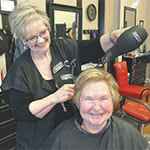Stylist happy to be back at work after shoulder replacement at Parkwest
 The sound of a blow-dryer fills a busy Sevierville salon. Paula Rawson raises her arm high over a customer’s head and tilts the dryer down to get the perfect angle for a new hairstyle.
The sound of a blow-dryer fills a busy Sevierville salon. Paula Rawson raises her arm high over a customer’s head and tilts the dryer down to get the perfect angle for a new hairstyle.
“This is what I couldn’t do before,” Rawson says with a grin. She expertly washes, cuts, colors, dries, combs and curls hair all day long, and is happy to do it, remembering a time not too long ago when work was painful.
As a matter of fact, Rawson lived and worked in pain for a full year before she finally found relief through shoulder replacement surgery at The Joint Center at Parkwest Medical Center. Today she is back at the salon doing the work she believes she was destined to do.
The source of Rawson’s pain was arthritis. “It’s hereditary,” she says. “My whole family has arthritis problems.”
Arthritis had already caused Rawson to have a knee and a hip replaced in previous years. She didn’t want to undergo surgery again, but as the pain in her shoulder became more intense and more consistent, doing her job became more and more complicated.
“I was hurting all the time,” Rawson says. The pain started to limit her day-today living, and at work she couldn’t raise the blow-dryer high enough to style hair properly. If she did manage to lift her arm as high as she needed to, she would find herself in tears from the pain.
Styling hair was taking longer “because I had to devise new ways to blow-dry hair,” she explains. This included using tactics like keeping the chair low, and blow-drying from different angles.
“That’s what hairdressers do,” Rawson says. “You compensate.” When she finally decided she’d had enough, she set about doing some homework, looking for a highly skilled surgeon who had plenty of experience.
“The doctors all have their specialties,” Rawson says. “I wanted to go to someone who’s done lots of shoulders. We asked around, and Dr. Brady was the one we chose.”
Dr. Paul Brady is a board-certified physician who specializes in shoulders. One might say he “wrote the book” on shoulder surgery, since he co-authored a top-selling orthopedic textbook titled, “A Cowboy’s Guide to Shoulder Arthroscopy.”
Rawson instantly felt comfortable with Brady and was ready to follow whatever path of treatment he recommended. “We tried therapy first,” Rawson says, “which bought me a little bit of time, but the pain was still there.”
Brady performed the much-needed procedure in January of this year at Parkwest. “I did a total shoulder arthroplasty,” he says, “which means I took out the arthritis in her shoulder, and I replaced it with a metal and plastic ball and socket, similar to hip or knee replacement.”
He says patients with arthritis usually enjoy quick relief from their pain because the arthritis is no longer there. Rawson had dreaded surgery, but is now grateful that she made the decision to go through with it, and she’s pleased with the whole experience at Parkwest’s Joint Center.
“Parkwest was wonderful,” Rawson says. “Every hospital needs to take a few lessons from Parkwest.”
Six weeks after surgery, physical therapy began. Rawson’s procedure hadn’t been complicated, and her shoulder area had no tearing, so she was able to work hard for recovery.
Rawson religiously followed the therapists’ orders, and after just a couple of sessions she was able to go back to work, saying, “I was on a mission, I went in there, I knew what I needed to do, and I did it.”
Shoulder pain can have a variety of sources, so recovery time varies depending on each patient’s diagnosis. But shoulder replacement is the third most common joint replacement in the United States, following hip and knee surgeries, and brings relief to thousands of new patients every day.
Rawson says if she had her life to live over, there’s no way she would spend a year in pain, delaying surgery. “I would never wait that long again,” Rawson insists. Brady explains that surgery shouldn’t be a quick fix, but it shouldn’t be delayed, either.
“I recommend that patients start to think about surgery when conservative measures are no longer working, such as cortisone shots or physical therapy,” Dr. Brady says, “or when they are so disturbed by their pain that they can’t sleep, and can’t perform functional, daily activities.”
Rawson has gone from living with pain to once again living a life she enjoys. That includes returning to the career she loves, with nothing holding her back.
“I can’t wait to get to work every day!” Rawson says.



